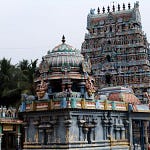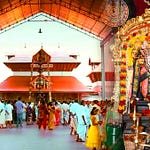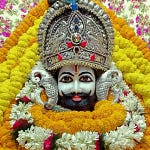A Temple Beyond Time and Space
In the heart of India’s spiritual geography lies a deeply revered yet less-commercialized jewel — Gangeshwar Mahadev Temple, a sanctum not just built with stones but carved by devotion, nature, and divinity. This temple, dedicated to Lord Shiva as the Lord of Ganga, is enveloped in mysticism, myths, and millennia of worship.
Here, Shiva and Ganga do not just co-exist; they dance together in cosmic rhythm. For those seeking moksha, healing, or a deeper connection with the universe — Gangeshwar is a calling.
Etymology & Cosmic Identity
"Gangeshwar" = Ganga (sacred river) + Ishwar (God) → God of the Ganga.
The deity is often described through the stotra:
"Nirakaram Omkaramoolam Turiyam..."
A verse meditating upon Shiva as the formless, Omkar-rooted, supreme fourth state of consciousness (Turiya), the master of mountains (Girish), time (Mahakaal), and compassion (Kripalu).
Historical and Mythological Origins
🧘 Vedic Lineage and Yogic Roots
The temple finds mentions in Puranas and Shaivagamas, believed to be established by ancient rishis such as Agastya, Bharadwaja, or Markandeya who performed austerities along the Ganges. It is said Shiva appeared here to bless yogis after they invoked him through rigorous tapasya.
🔱 Ganga's Descent & Shiva’s Role
One prominent legend ties it to Bhagiratha's penance, where Lord Shiva caught the descending Ganga in his jata (matted hair) to prevent Earth’s destruction. The exact spot where Ganga first trickled down is believed to be near the sanctum of Gangeshwar — giving it unparalleled sanctity.
Architectural Marvel & Temple Layout
🧱 Design & Layout
Nagara style structure with lotus dome spires.
A square Garbhagriha (sanctum) housing the naturally-formed Shivling.
Mandapam for rituals, flanked by corridors lined with mural depictions of Shiva's stories.
🌊 Unique Feature
The Shivling is continuously anointed by natural Ganga water — either through a natural stream or an underground spring. This symbolizes Shiva in eternal tapasya under the flow of divine consciousness.
Daily Rituals and Sacred Timings
The day at Gangeshwar Mahadev Temple begins with the Mangala Aarti at 5:00 AM, a sacred morning invocation performed with the resonating sound of bells, damaru, conch shells, and the chanting of Vedic shlokas that fill the air with divine vibrations.
Following this, between 6:00 AM to 8:00 AM, the revered ritual of Ganga Jal Abhishek is conducted, where devotees and priests pour sacred water from the River Ganga over the Shivling, symbolizing purification and the eternal flow of divine grace.
Starting from 8:00 AM onward, the Bilva Puja is performed. This involves the offering of bilva (bel) leaves, dhatura flowers, sacred ash (bhasma), and other auspicious items known to be dear to Lord Shiva. Devotees chant mantras and offer their prayers during this deeply spiritual ritual.
The powerful Rudrabhishek, a ritual that involves the Vedic chanting of Rudra hymns from the Yajurveda, is performed either by appointment or more commonly on Mondays, which are considered highly auspicious for Lord Shiva. This ritual is known for its immense potency in washing away negative karmas and invoking Lord Shiva's blessings.
As the sun begins to set, the Sandhya Aarti is performed at 6:30 PM. This evening prayer is a mesmerizing experience where lamps (deep daan) are offered, conch shells are blown, and devotional songs are sung, creating a serene and spiritually charged atmosphere.
The day's spiritual journey concludes with the Shayan Aarti at 9:00 PM, which is the final prayer before the temple doors close for the night. It is a moment of intimate devotion, where the deity is put to rest amidst chants and offerings, preparing the temple to welcome another day of divine worship.
Pujas, Festivals & Occasions
🗓️ Key Celebrations
Mahashivratri: Thousands participate in night-long jaagran, bhajan, and tantric puja.
Shravan Maas: Peak month of devotion — daily rituals, kanwariyas, and thousands of Shiva bhakts.
Pradosham: Bi-monthly vrat with rituals to cleanse karmas.
Amavasya & Somvati Amavasya: For pitr dosh nivaran and ancestral blessings.
🛐 Special Pujas
Laghu Rudra / Maharudra
Panchamrit Abhishek
Mrityunjaya Homam
Kal Sarp Dosh Nivaran
Pitru Tarpan and Shraddh rituals
Spiritual Significance & Liberation Power
Gangeshwar is not just a place of worship — it’s a gateway to moksha. It is said:
"Jo Ganga ke kinare Shiva ko dhyaye, uski yatra kaantimayi hoti hai."
(He who meditates upon Shiva on Ganga’s banks walks the path of light.)
Worship here grants relief from kaal sarp dosh, graha doshas, unfulfilled karmas, and fears.
Considered equivalent to Kashi Vishwanath, but without commercial excess.
Travel & Darshan Guide
📍 Location
Exact coordinates vary (state/city depending on actual location; there are multiple Gangeshwar Mahadev temples across India — e.g., Somnath, Uttarkashi, Varanasi outskirts). Please confirm.
🚍 How to Reach
By Air: Closest airport within 50–100 km radius.
By Train: Nearby junction stations with autos/cabs to the temple.
By Road: Regular buses or private cars. Ample parking nearby.
🏨 Stay & Facilities
Dharamshalas, Yatri Bhavans, and Ashrams are run by temple trust and local samitis.
Basic medical aid, prasad stalls, and guide services available.
Mobile cloakroom and Ganga snan changing rooms provided.
Devotees, Yogis, and Sadhus
Naga Sadhus, Bhairavi practitioners, and Shaiva yogis gather here for tapasya.
Local villagers, city devotees, and international seekers visit for meditation and chanting.
Kundalini seekers, tantric meditators, and Gyan margis often choose the temple's nearby ghats as their retreat.
Mystical Legends and Secrets
Self-manifested Shivling believed to rise during Sharad Poornima nights.
Underground stream from Himalayas feeds Ganga into the temple — origin unknown.
Some believe a hidden jyotirlinga lies beneath the current lingam, accessible only to siddhas.
Tantric rituals are whispered to still be practiced here under the guidance of elevated sadhus.
Literary Mentions & Shaiva Canon
Referenced in Kashi Khand, Skanda Purana, and Agama texts.
Swami Samarth, Bharati Tirtha, and local saints have written bhajans in its glory.
The temple is part of regional pilgrim circuits and recognized by certain Akhadas.
Pilgrimage Tips & Devotee Guidance
Visit before sunrise for spiritual silence and empty darshan.
Bathe in Ganga before darshan.
Recite the Rudram or Maha Mrityunjaya Mantra while circumambulating the temple.
Donate for cow feeding, free annadaan, or lighting diyas.
Tirth and Surroundings
Nearby ghats offer opportunity for Ganga Snan.
Caves, temples, and kunds nearby include sacred ponds where rishis meditated.
Some areas are reserved for meditation retreats — silent zones for tapasya.
Visual & Cultural Experience
Evenings are adorned with ghanta naad, mantra chanting, and shringar aarti that turn the place into a celestial experience.
Deep daan on Kartik Purnima is a mesmerizing sight with thousands of diyas floating on the river.
Gangeshwar Mahadev Temple is not merely a location — it is a spiritual forcefield, a vibration, a cosmic silence where Lord Shiva breathes through the flow of Ganga.
To walk here barefoot is to step into eternity.
To bow here is to surrender ego.
To chant here is to unlock lifetimes of karmic knots.
Whether you are a pilgrim, poet, yogi, or seeker — this temple invites you into the fold of timeless devotion.










